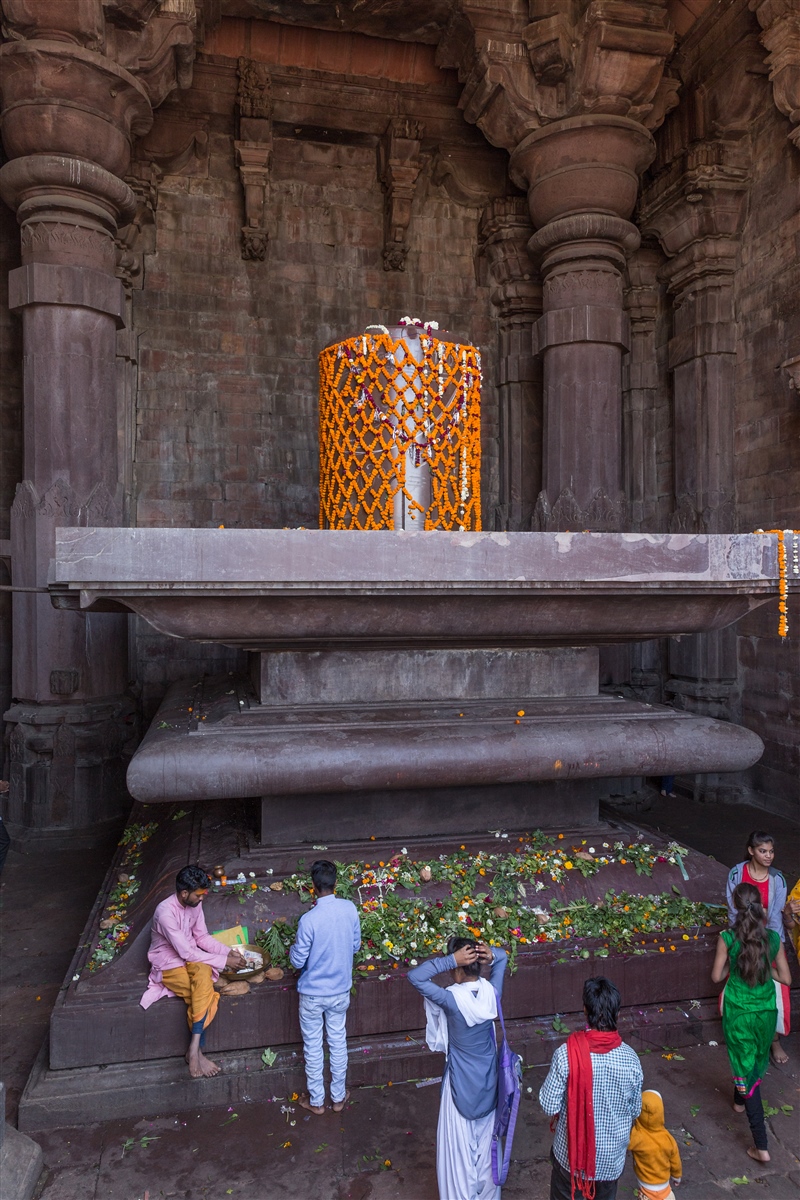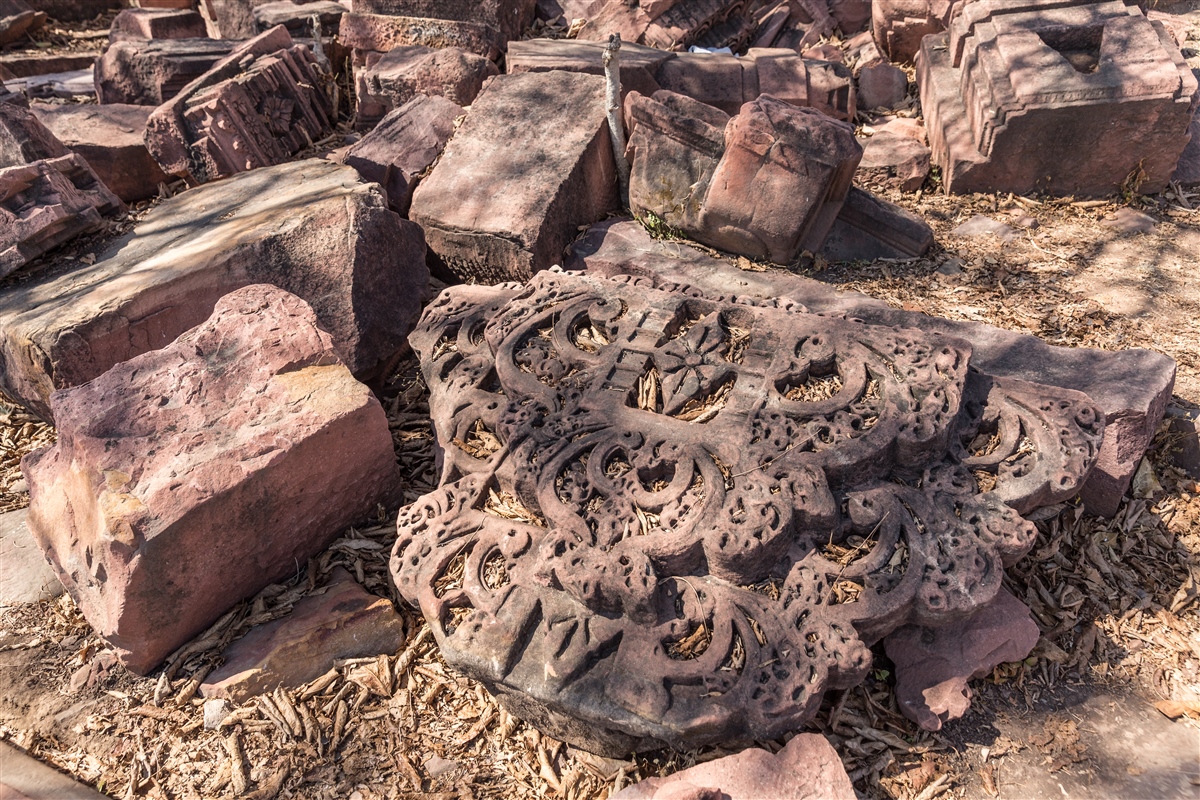Bhojpur is just 30km south east of Bhopal, and makes for a great stop-off point on your way back to the city if you have visited the Bhimbetka Rock Shelters in the morning.
The village is most famous for the great Bhojeshwar Temple, attributed to the Paramara ruler Raja Bhoja who reigned between 1010 and 1055 B.C.E. The Paramara dynasty ruled Malwa and surrounding areas in west-central India between 9th and 14th centuries, and Raja Bhoja is perhaps their most famous king. Bhoja fought numerous wars with nearly all his neighbours with a view to extending his kingdom, but with varying degrees of success. At its zenith, his kingdom extended from Chittor in the north to upper Konkan in the south, and from the Sabarmati River in the west to Vidisha in the east. As well as a warrior, Bhoja is best known as a patron of arts, literature, and sciences, who processed formidable vision. He wrote many books on subjects as varied as religion, medicine, grammar and architecture.
The west-facing Bhojeshwar Temple is quite unlike any other structure I have seen in India, contributed in part by the fact that it was never finished. This has made dating the structure a little difficult as there is no dedicatory inscription, although by the style of the sculpture and this temple having the same mason marks as a nearby Jain temple, experts have with some confidence tied down a date to the 11th century, and therefore to Raja Bhoja.
There are a number of somewhat odd elements to the temple as we see it today. There is no mandapa connected to the sanctum, and it has a rectilinear roof as opposed to the more typical curvilinear domed tower. Three of the temples walls are completely plain on the exterior, with just a few carvings on the entrance wall that don’t look as though they originally belonged there. These anomalies have led some people to believe that the temple was in fact a funerary monument, but in reality what we are seeing here is an ambitious building project that was never completed.
The temple lies on a platform 35m long, 25m wide and 4.0m high. On the platform lies a sanctum containing a very large lingam, 2.3m high and 5.4m in circumference. This is reputed to be the second largest lingam in the Indian subcontinent.
The temple has undergone a few phases of renovation and conservation in recent years. By 1950 the building had become structurally unsafe due to rainwater percolation and the previous removal of stone veneers. The site was handed over to the A.S.I. in 1951 for conservation, leading to some repairs being made in the early 1990s.
However, it wasn’t until 2006 that serious restoration of the monument commenced. A 12 tonne missing pillar was carved out of a single stone by expert masons and integrated into the building, the stone itself having been sourced near Agra after extensive searches to find stone that matched the original fabric of the building. It took a modern day team 6 months to source, carve and install that pillar – so one can only imagine the sheer amount of labour deployed whilst this temple was originally being constructed.
During this time the temple ceiling, never completed and open to the elements, became another part of the structure that needed attention. The temple ceiling was closed, but not using stone which could have potentially damaged the structure, but instead using fiberglass. Obviously a fraction of the weight, but I have to say they have done a really good job here. I was completely unaware that the roof was fiberglass as I spent a few minutes photographing it !
This is an active temple, my visit coinciding with a local festival that was taking place. So both the temple and the precinct in front has a hive of activity.
Construction of the temple appears to have come to a very abrupt stop, the evidence of which can be seen all over the site. In fact, you could be mistaken for thinking it was abandoned only the day before, or that perhaps everyone has just stopped for a lunch break !
First we have a curious structure behind the temple – the remains of a large sloping ramp erected for carrying the carved slabs of stone from the adjacent quarries to the temple site. The incline of the slope clearly indicates that this ramp was being used to haul masonry up to the upper levels of the temple.
The quarries themselves, right next to the temple, also have evidence of work in progress.
Here you can see unfinished architectural fragments scattered far and wide in various stages of extraction from the bedrock, and some where more intricate carving had already started in-situ.
Not only that, but detailed architectural plans for the finished temple can actually still be seen scoured into the rock of the quarry. These architectural plans (difficult to see in the photographs, click each one to enlarge) indicate that the original intention was to build a massive temple complex with many more temples. If these plans had been fulfilled, it would have made Bhojeshwar one of the largest temple complexes in India.
So the nearby rock bed not only served as a quarry, it was also their drawing board. Many of the architectural plans are now very hard to make out, but a few are in 1:1 scale and so are life size. Scholars who have studied these plans have come to the remarkable realisation that what we see today is just a mere fraction of the main temple that was envisaged by Raja Bhoja. Had this temple been completed, the shikhara would have scaled to the astonishing height of 100m, which at the time would have made this the tallest Hindu temple anywhere in the world.
To put this grand project into perspective, here are the heights of a few other broadly contemporary temple structures in India :
| Temple | Location | Height |
| Bhojeshwar | Bhojpur | 100m |
| Brihadeeswarar | Thanjavur | 66m |
| Jagannath | Puri | 66m |
| Lingaraj | Bhubaneswar | 56m |
| Sun Temple | Konark | 40m (now) 70m (complete) |
Raja Bhoja’s grand plans did not stop here, he also had the wider landscape to remodel. He constructed three dams in the region (now breached) which once created a huge artificial lake by the side of the Bhojeshwar temple measuring a staggering 18.5 miles long and 7.5 miles wide. The first dam, built on Betwa River, trapped the river waters in a depression surrounded by hills. A second dam was constructed in a gap between the hills, near present-day Mendua village. A third dam, located in present-day Bhopal, diverted more water from the smaller Kaliasot river into the Betwa dam reservoir. This man-made reservoir existed until the early 15th century, when the dams were breached and the lake emptied by Hoshang Shah, the first formally appointed Sultan of the Malwa Sultanate.
Historians continue to speculate as to what triggered the abandonment of construction at this site. Was there a sudden natural disaster ? A lack of resources ? An unexpected war ? Or was there a fundamental problem with the temple construction that led to the original roof collapsing, and so circumstances prevented Bhoja from ever rebuilding it. We will of course never know for sure, perhaps his great vision was simply too ambitious to achieve ?
Beyond the quarry and not far from the banks of the Betwa river lies the ruined remains of a Shiva temple. The masons marks found on some of the blocks of stone match that which can be found on the nearby Bhojeshwar Temple, so the two structures are believed to be contemporary.
I have to confess to not reading up much about Bhojpur and the Bhojeshwar Temple prior to visiting. It turned out to be an unexpected delight, and quite unlike anywhere else I have visited in India. If you’re staying in Bhopal for any length of time it’s well worth making the effort to see this place, and marvel at Raja Bhoja’s ambitious plans that were sadly never realised.
For those who are interested in discovering how the architectural plans drawn on the rocks was extrapolated into a vision of the intended complete temple, I highly recommend the following 20 minute YouTube clip by Professor Adam Hardy, Emeritus Professor at Cardiff University.
Please ‘Like’ or add a comment if you enjoyed this blog post. If you’d like to be notified of any new content, just sign up by clicking the ‘Follow’ button. If you have enjoyed this or any other of my posts, please consider buying me a coffee. There’s a facility to do so on the righthand side of this website for desktop users, and just above the comment section for mobile users. Thank you !
If you’re interested in using any of my photography or articles please get in touch. I’m also available for any freelance work worldwide, my duffel bag is always packed ready to go…
KevinStandage1@gmail.com
kevinstandagephotography.wordpress.com
Categories: Bhojeshwar Temple - Bhojpur, India, Madhya Pradesh








































wonderful pics. Your post made me remember our trip to Bhojpur.We covered Bheembetka and Bhojpur temple in single day. In fact we visited there while on our way back from Satpura National park hence did not have much time in hand and missed out roaming around, going to dam area or that of jain temple etc.Enjoyed the write up . Here is my experience of the temple.
https://destinationsinindia.blogspot.in/2013/03/shiva-temple-of-bhojpur.html
LikeLiked by 1 person
What a marvelous essay. What excellent pictures. Our group Tamil Heritage Trust (tamilheritage.in) visited this temple and the nearby Ashapuri temple in January 2019 (I didnt know about the fiberglass ceiling or the restoration until I read your article.
Thank you so much.
LikeLiked by 1 person